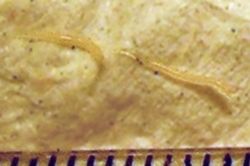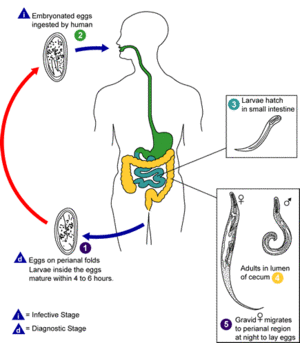Pinworm facts for kids
Quick facts for kids Pinworm |
|
|---|---|
 |
|
| A pinworm (Enterobius vermicularis). | |
| Scientific classification | |
| Kingdom: | |
| Phylum: | |
| Class: |
Secernentea
|
| Subclass: |
Spiruria
|
| Order: |
Oxyurida
|
| Family: |
Oxyuridae
|
| Genus: |
Enterobius
|
| Species | |
|
|
Pinworm is a common infection caused by tiny parasitic worms that live in the intestines. These worms are a type of roundworm. Millions of people, especially children, get pinworm infections every year.
Contents
What are Pinworms?
Pinworms are small, white, thread-like worms. They are very tiny, usually less than half an inch long. They get their name because the female worm has a long, pointed tail.
These worms are parasites, meaning they live on or inside another living thing (called a host) and get their food from the host. In this case, humans are the hosts.
How Do Pinworms Spread?
Pinworm infections spread easily from person to person. This happens when someone accidentally swallows pinworm eggs.
The eggs are microscopic, so you can't see them. They can be found on fingers, clothes, bedding, toys, and other surfaces.
When a person with pinworms scratches their bottom, eggs can get under their fingernails. From there, eggs can spread to anything they touch.
If someone else touches these contaminated items and then puts their fingers in their mouth, they can swallow the eggs.
Pinworm Life Cycle
Pinworms have a simple life cycle that takes place entirely in humans.
1. Eggs are Swallowed: The life cycle begins when a person swallows pinworm eggs. 2. Hatching in the Intestine: Once inside the body, the eggs travel to the small intestine. There, they hatch into tiny larvae (young worms). 3. Growing in the Colon: The larvae then move to the large intestine (colon). They grow into adult worms over a few weeks. 4. Egg Laying: When the female worms are ready to lay eggs, they travel out of the anus, usually at night. They lay thousands of sticky eggs on the skin around the anus. 5. Itching and Spreading: This egg-laying often causes itching. When a person scratches the itchy area, eggs can get on their fingers and spread.
What are the Symptoms?
The most common symptom of a pinworm infection is intense itching around the anus, especially at night. This itching can make it hard to sleep.
Other symptoms might include:
- Restless sleep or irritability
- Loss of appetite
- Weight loss (less common)
- Mild stomach pain (rare)
Sometimes, people have pinworms but show no symptoms at all.
How to Prevent Pinworms
Preventing pinworm infections involves good hygiene habits.
- Wash Hands Often: Always wash hands thoroughly with soap and water, especially after using the bathroom, before eating, and after playing outside.
- Keep Fingernails Short: Trim fingernails regularly to reduce places where eggs can hide.
- Avoid Scratching: Try not to scratch the anal area.
- Shower Daily: Shower or bathe every morning to help wash away eggs laid overnight.
- Change Underwear: Change underwear daily.
- Wash Bedding: Wash bedding, pajamas, and towels often in hot water.
How are Pinworms Treated?
Pinworm infections are usually easy to treat with medicine. A doctor can prescribe special anti-worm medicine.
Often, everyone in the household needs to be treated at the same time. This helps stop the infection from spreading or coming back.
It's also important to continue good hygiene practices during and after treatment to prevent reinfection.
Images for kids
See also
 In Spanish: Enterobiasis para niños
In Spanish: Enterobiasis para niños



